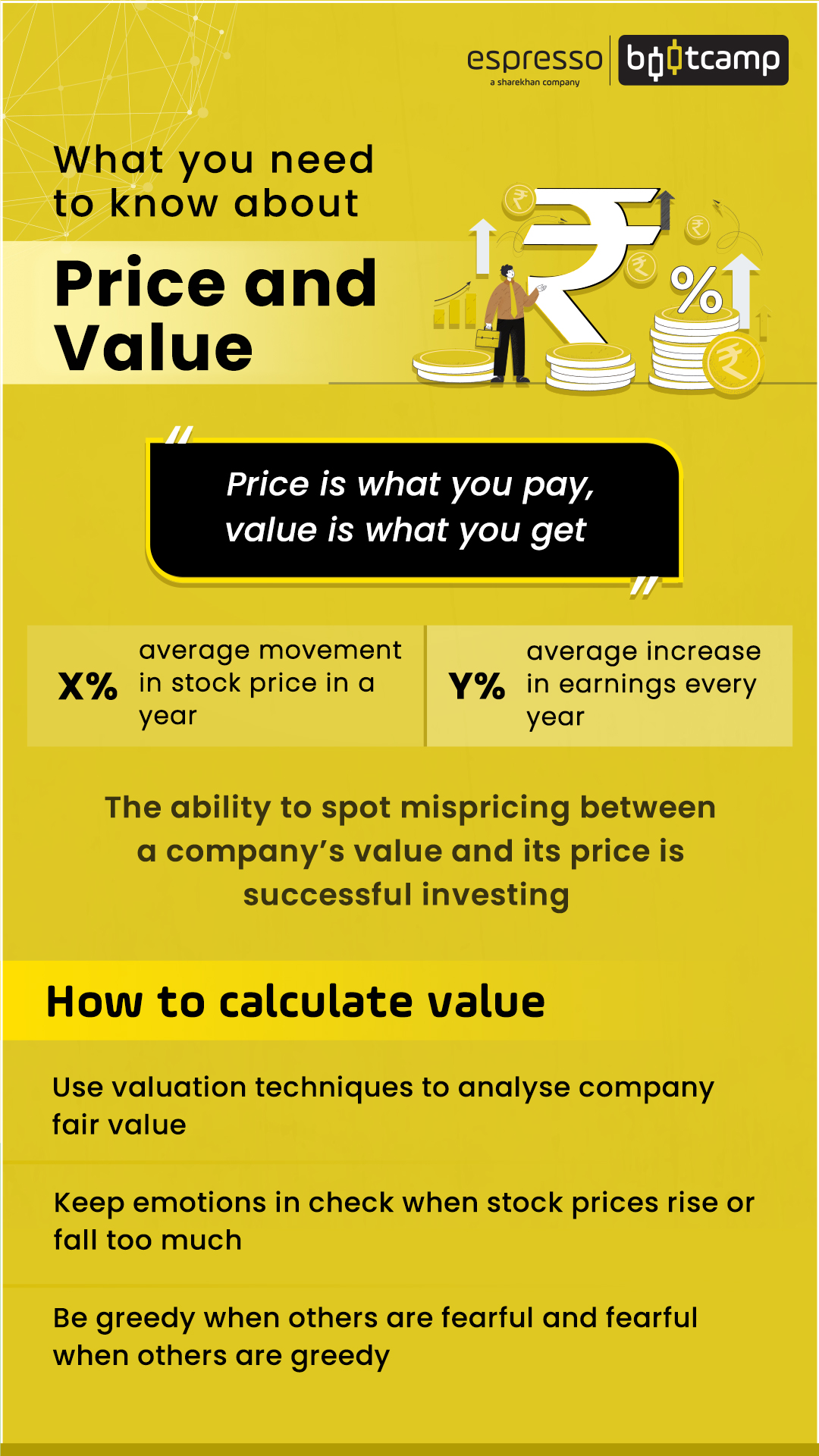In common parlance, we tend to use the words cost, price and value interchangeably. However, all three terms have entirely different meanings and purposes. Let’s do a deep dive and understand this.

Difference between price and value
Before understanding what is the difference between price and value, we should also have an idea of what cost means.
Cost is nothing but expenditure. It is the amount expended to bring a product to a stage of utility before selling it for profit. Cost is a visible monetary expenditure and can be broken down into various elements such as raw material expenses, labour, rent, overheads, etc.
Now, let's look at how price and value differ.
Definition of Price: In everyday terms, price is what one pays to buy a product. Price is just a markup above cost, and buyers can bargain for their preferred price in a competitive market. When profit is added to cost, it becomes the selling price. Sometimes, a product is sold at cost or below cost, but this is an exception.
Definition of Value: Value is the utility or worth of a product for its buyer. Bringing a dishwasher home by paying the price has value as it saves time, effort and money (paid to house help). Savings in terms of time and money is the benefit that a person derives, and this amounts to value.
Quantifiable or not?
Cost: This is quantifiable and should be perceived from the angle of manufacturers.
Price: This is also quantifiable and is considered from the sellers’ perspective.
Value: This is not quantifiable and is from the buyer’s point of view. Value has to be assumed and isn’t immediately realised like price. It takes time for value to reveal itself. Also, value is a perception and, therefore, different for different people. It is a combination of features, utility, design, etc. that are available in a product or service from a user's perspective.
Price and value of equity shares
The concepts of price and value are much simpler in the stock market universe as they involve merely buying and selling stocks.
Stock price
The current market price of a stock keeps fluctuating due to demand and supply. Stock price increases with an increase in buyers. A rise in demand drives up the stock price. On the other hand, with more sellers offloading their stocks, the price falls. Many participants in the stock market take advantage of small price changes that create a demand-supply scenario.
Speculators who trade in huge volumes, arbitrageurs who take advantage of pricing mismatches in different exchanges, hedgers who hedge their investment positions from particular risks and long-term investors who buy and hold stocks and, therefore, provide liquidity in the stock market by quickly buying and selling shares.
While it is easy to understand demand and supply, it is difficult to understand why a company is liked or disliked, leading to price fluctuations. The reasons can be multiple; from a positive economic environment, good business practices, healthy financials, sound management and business models. Apart from this, status in the industry, bargaining power, barriers to entry, etc., determine the attractiveness of a company.
Stock value
Stock value, on the other hand, is perception driven, therefore, less prone to fluctuations. Value means the intrinsic or fair value or inherent value of a stock. The parameters to evaluate the intrinsic value can be based on the company's fundamentals, expected growth, risk environment, industry structure and status within the industry.
Intrinsic value has to be calculated, and the calculation differs from person to person. You will come across research reports of the same company with differing intrinsic values. This is because the analysts calculating them are different. This shows that, while broadly, the data and assumptions may be the same, subjectivity influences intrinsic value.
Methods of deriving intrinsic value in stock market
Discounted cash flow method is where the future cash flows of a company are estimated and discounted at a rate to arrive at the present value.
Dividend discount model is a method based on the premise that investors buy stocks to earn dividends. This uses future dividends to arrive at the intrinsic value and has several variants.
Net assets value method is used in the case of asset-heavy businesses such as real estate, shipping, aviation, etc. In this method, assets are reduced by liabilities to arrive at net assets. Net asset divided by outstanding equity shares gives net asset value per share.
What isn’t intrinsic value?
Price: Price isn’t intrinsic value, so don’t get confused between price and value.
Enterprise value: Similarly, enterprise value (EV) is not considered intrinsic value and changes every time the price changes. This value is calculated by adding market capitalisation to borrowings and deducting cash and cash equivalents. This is because market capitalisation is a product of price and outstanding equity shares. However, a multiplier of EVs is used as a popular method of arriving at intrinsic value.
Book value: This value is calculated as total assets deducted from total liabilities. The resultant figure is divided by an outstanding number of equity shares to arrive at book value per share.
We conclude the concept of price and value with this quote from one of the most successful value investors, Warren Buffet, “Price is what you pay, and value is what you get”.
Points to remember:
- The meanings of price and value are different in stock markets
- Understanding stock price and stock value is crucial for prospective traders and investors
- Intrinsic value of a stock needs to be figured out to know its potential
 0
|
0
|
 0
0
 Modules
Modules

 Watch
Watch 
